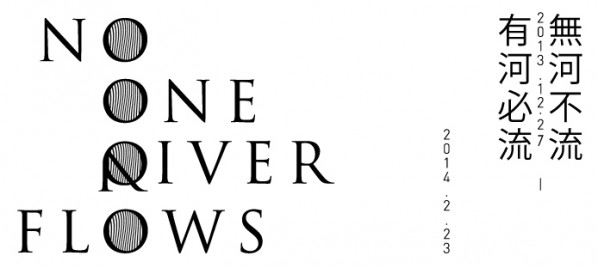
No man (sic.) ever steps in the same river twice…-Heraclitus 6th Century BC
The preceding quote is something that was reputedly said by the ancient Greek philosopher Heraclitus, though everything we know about him is from second-hand accounts. If Greek thought was about to flourish and dominate for the next three millennia, continuing on into our own tenuous and exhausted present, Heraclitus was in its earliest days the sharpest voice of dissent, attacking its foundations with his philosophy of flux. One hundred years later he would be criticised by Plato, and then Aristotle, for violating the first principle of the law of non-contradiction, without which, they claimed, scientific knowledge would not be possible. But while stating from the outset that humans are too stupid to understand his theories, Heraclitus propelled forward an alternative strain of thought that has survived but never prospered.
Perhaps a wayward son of the aristocracy, Heraclitus described himself as being "self-taught". He attacked Pythagoras, the founder of Mathematics, as a fraud. Whereas Pythagoras and his secretive cult-like following worshipped numbers whose harmony they believed to be the basis of nature, Heraclitus stated that there are no stable entities. "Nothing endures but change". Instead there is the ebb and flow of matter which connects and forms into constellations, but only momentarily, before separating apart. Not only could one not step twice into the same river - as the moment one has stepped into the river it is already no longer the same - but also, one would not be the same person. Heraclitus allowed no stable unitary identity. Rather than a philosophy of objects and being, it is a philosophy of process and becoming.
Heraclitus appears to have been extremely isolated. He was frequently derided, called "The Weeping Philosopher", as a commentary on his melancholia but also as a slight on his famous river aphorism. Raphael, in his famous fresco "School of Athens", figured Michelangelo as Heraclitus, separate and aloof from the other philosophers, moody and alone. And yet his philosophy could not be ignored. Plato often referred to it and in a sense agreed with Heraclitus but worked around his theory by stating that while the material world is in flux and full of illusion, behind this world is another plane of pure forms where true reality resides. Plato famously uses his cave analogy to describe slaves inside the cave watching the flickering shadows on the walls generated by a fire they cannot see. This illusion is the closest they will get to reality and they can never know the pure forms. Only the philosopher through reason could escape this enslavement and begin to understand reality and truth. Plato's pure forms posited a transcendental human subject but formed a foundation for human knowledge in the face of Hericlitus' radical challenge.
When Marcel Duchamp exhibited his urinal, he threw the status of the object, which was so important to the culture of industrial capitalism, in question. Its meaning appeared not as an inner or innate quality but more determined by its multiple relations and position as inserted into a network of signs. Dada disrupted the composed centered human subject that had been developing since the Renaissance , and introduced chance and non-rationalism into the equation. Throughout the twentieth century there was a drive towards countering the fetishised art object and the position of spectator within the logic of exhibition. Fluxus, conceptual art, Happenings, and process art, were among those strains challenging the hegemony of the reified art object; even if these experiments rarely impacted beyond the art world and its institutions. By the eighties though the large neo-expressionistic canvas was back in vogue, with once-radical expressionism now codified for the market, and art has in a general sense got bigger, more expensive, typically veering towards the spectacle that is at the heart of this publicity age.
Enter economic collapse, major global power shifts and the other side of optimism in regards to ideology, and process can be seen to be tugging its way to the forefront of possible relevancy again. If social media has hollowed us out and turned our most intimate connections into publicity stunts and promotional activities, then more process-based art and events conjulating disparate and '"purposeful yet purposeless" activities could be an anecdote to the pimped-out-ed-ness we feel from the management of the abstract self-image we produce, maintain and administer through the digital manipulation mechanisms we call home. There is a calling in these times for an art of the event, the unpredictable channelling together of multiple incommensurate flows.
The exhibition "No One River Flows" at Kuangdu Museum in Taipei. Curated by WANG Chun-Chi, the exhibition features work dealing with process more than the immediacy of the retinal, veering towards the ethemeral, by TING Chaong-Wen, LIN Kuo-Wei, CHENG Ting-Ting, Chihiro Minato, Olaf Hochherz, WANG Fujui and Rohwa Jeong. These works invite the exhibition attendee to enter into the fray, and consider themselves beyond the mere relation of visual spectator in the art they are experiencing.
About the exhibition
Duration: 27 Dec 2013 - 23 Feb 2014
Venue: Kuandu Museum of Fine Arts
Opening Reception: 27 Dec 2013 Fri 17:00
Opening Time: 10:00-17:00 (Tue - Sun)
Tel: 886-2-28961000
Add: 1 Hsueh-Yuan Road, Peitou, Taipei, Taiwan
Courtesy of the artists and Kuangdu Museum, for further information please visit www.kdmofa.tnua.edu.tw.




























